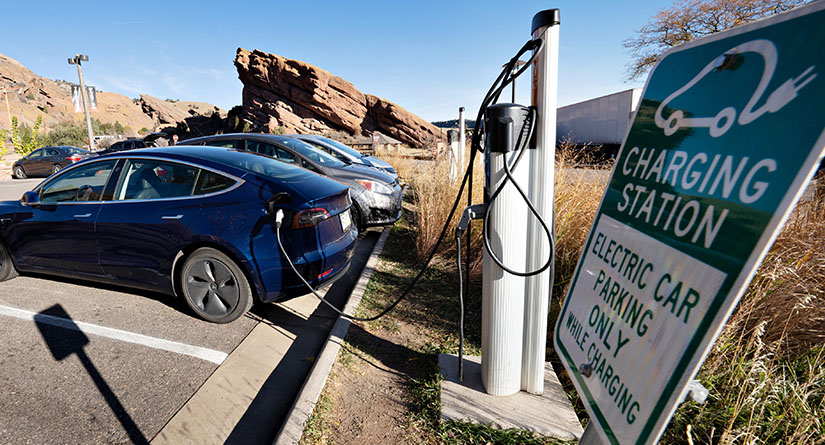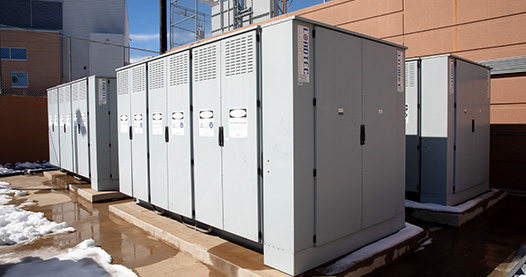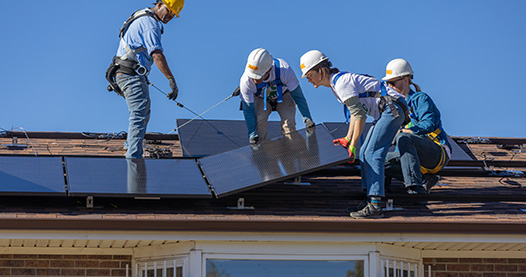Clean Energy to Communities Program: Peer-Learning Cohorts
Clean Energy to Communities (C2C) offers peer-learning cohorts to advance local clean energy goals. Peer-learning cohorts are funded by the U.S. Department of Energy and managed by NREL with support from the World Resources Institute.

What Are C2C Peer-Learning Cohorts?
Peer-Learning Open Opportunities
Apply by Thursday, Oct. 31, 2024, for one of three new peer-learning cohorts.
Peer-learning cohorts are multicommunity engagements that convene community entities around a common clean energy transition topic. Participants meet regularly for approximately 6 months to exchange strategies and best practices, learn in a collaborative environment, and workshop policy or program proposals, action plans, or strategies to overcome challenges.
In each cohort, experts provide up to 15 participants with case studies, analysis and modeling tools, templates, training materials, and facilitated collaboration to enable accelerated clean energy progress.
Nearly 200 community entities have participated in one of 12 cohorts.
Upcoming Peer-Learning Cohort Topics
C2C is now accepting applications for the following three cohort topics:
Cohort Description
This cohort will cover the types and scales of microgrids, the basics of how they
work, the costs and benefits, and funding and procurement strategies. Cohort members
will:
- Learn from, and exchange ideas with, other participants while receiving assistance and support from national lab subject matter experts
- Access tools and strategies to conduct community engagement to align microgrid projects with community resilience priorities
- Share experiences and approaches for working with varying regulatory and utility situations
- Learn how to maximize microgrid benefits by exploring site characteristics, technology designs, electrical performance goals, and financial considerations.
Expected Outcomes
Participants will understand how to account for the financial, economic, regulatory,
and resilience considerations of a microgrid project; identify potential technologies
to deploy as part of a microgrid; develop a use case for any additional investment
requirements; and plan next steps for refining their project scope and timeline.
Ideal Participants
Priority will be given to entities in areas with significant risk of weather-related
emergencies, grid instability, or power outages, including those that are located
in islanded or remote communities.
Eligible Entities
- Local governments (cities, towns, villages, counties, etc.)
- Regional organizations (councils of government, etc.)
- Municipal utilities or electric co-ops
- Tribes, including Alaska Native Villages, Alaska Native Corporations, and state-recognized Tribes
- Community-based nonprofit organizations
- Nonprofit colleges or hospitals
Download the microgrids application questions and submit your application by Oct. 31.
Cohort Description
This cohort will introduce entities representing rural and agricultural communities
to distributed wind technologies. Distributed wind consists of small-scale wind turbine
installations that allow individuals, communities, and businesses to reduce electricity
costs and increase revenue through local, carbon-free energy generation. Participants
will explore key levers for success, including permitting, zoning, financing and ownership
models, and building awareness in key markets such as the agricultural sector. Additionally,
they will learn about available tools and technical assistance that can help them
explore resource and economic viability of distributed wind in their own contexts.
Expected Outcomes
This cohort will provide participants with resources to build local capacity, both
internally and within partner entities, and explore distributed wind opportunities.
As a final output, participants will develop a blueprint that establishes a local
vision and goals for distributed wind; highlights possible updates to local plans
and processes related to distributed wind; identifies sites for potential deployment;
and outlines strategies to support key regional stakeholders as they advance distributed
wind projects.
Ideal Participants
All participants must represent a rural, remote, or agricultural community. Prospective
participants must demonstrate why there is an interest in distributed wind. The cohort
will prioritize participation by entities that work directly with farmers.
Eligible Entities
- Local governments, especially rural counties, towns, and villages
- Tribes, including Alaska Native Villages, Alaska Native Corporations, and state-recognized Tribes
- Regional development organizations (councils of government, etc.)
- Economic development corporations
- University cooperative extensions
- Cooperative and municipal utilities
Download the distributed wind application questions and submit your application by Oct. 31.
Cohort Description
This cohort will explore available renewable energy and energy efficiency technologies,
including their procurement processes, available funding and financing opportunities,
and other deployment factors. Participants will learn about community engagement and
other strategies to ensure the new energy economy results in community benefits, and
they will outline next steps to leverage these technologies for economic and workforce
opportunities in Appalachia.
Expected Outcomes
This cohort will help participants plan to integrate next-generation energy production
and energy efficiency technologies while learning from their peers across Appalachia
and technical experts. Participants will share their next steps with one another at
the end of the cohort, including opportunities to address basic services and local
priorities through energy projects.
Ideal Participants
Ideal participants for this cohort are local governments and regional organizations,
economic development districts, and Tribes in Appalachia that are interested in learning
more about renewable energy and energy efficiency and want to connect and exchange
ideas with aligned peers in the region. Participating entities do not need to have
dedicated energy or sustainability staff members, but participants must be willing
to dedicate approximately 4 hours per month to cohort activities.
Eligible Entities
- Local governments (cities, towns, villages, counties, etc.)
- Regional organizations (councils of government, etc.)
- Economic development organizations
- Tribes, including state-recognized Tribes and Tribal organizations
- Community-based organizations that are working in partnership with a specific local government, regional government, or Tribe
Applicants must be located in Appalachia.
Download the Appalachia application questions and submit your application by Oct. 31.
Apply by Thursday, October 31, 2024. Each peer-learning cohort will commence in January 2025.
Stories and Lessons Learned
Reading, Pennsylvania, Finds Value of Energy Savings Performance Contracts Through C2C Program, NREL News (2024)
Coalitions Foster New Relationships To Facilitate Coordinated Clean Transportation Efforts, Clean Cities and Communities News (2024)
U.S. Department of Energy Welcomes New Round of Innovative Leaders to Peer-Learning Cohorts on Emerging Clean Energy Strategies, U.S. Department of Energy's Office of Energy Efficiency and Renewable Energy (2024)
Peer Learning Helps San Diego Center Community Voices in Clean Energy Plans, NREL News (2024)
Joint Office of Energy and Transportation's Public Electric Vehicle Charging Infrastructure Playbook, Joint Office of Energy and Transportation
Lessons Learned From the Clean Energy to Communities Peer-Learning Cohort on Planning and Funding for Electric Vehicle Charging Infrastructure Deployment, NREL Fact Sheet (2024)
Electric Vehicles Grow in the Desert: Peer Learning Helps Sedona Plan for Charging Infrastructure, NREL News (2024)
C2C Peer-Learning Cohorts Participants
For a list of current and past cohorts, visit the Current and Past Peer Learning Cohorts page.
Eligibility
Peer-learning cohorts are intended for participants that have decision-making power or influence in their community entities but need access to additional clean energy expertise to inform upcoming opportunities. Eligible primary applicants for cohort topics may include:
- Tribes, including Alaska Native Villages, Alaska Native Corporations, and state recognized Tribes
- City, town, or county (local) governments
- Metropolitan planning organizations
- Regional planning organizations
- Municipal and cooperative utilities
- Community-based organizations
- Other public entities, such as transit agencies, school districts, and housing authorities.
Contact
If you have questions about C2C Peer-Learning Cohorts, please email C2C.
Sign up for C2C email updates to be notified when program applications open.
Share



